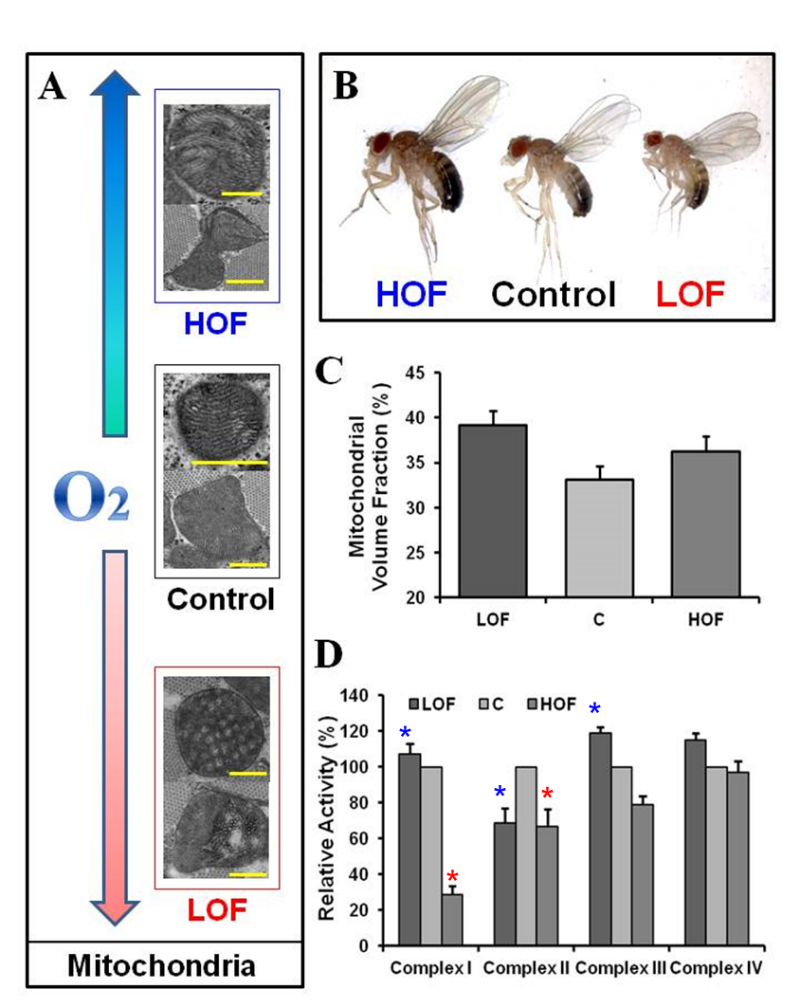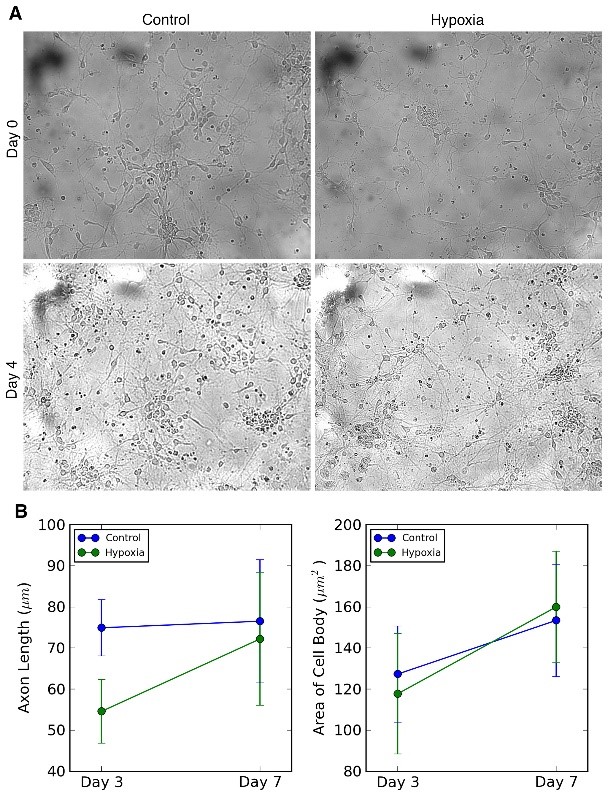
Project 1. Genetic Mechanisms Underlying Tolerance to Extreme Oxygen Conditions in Drosophila Model. Hypoxic or oxidative injuries occur in many clinical conditions, such as pulmonary disorders, cardiac infarction, ischemic stroke. Understanding the mechanisms underlying tolerance or susceptibility to hypoxic or hyperoxic stress is essential for identifying targets to develop novel therapeutic or preventive strategies. In the past decade, we generated Drosophila melanogaster populations through experimental evolution that can tolerate and live perpetually in the environments containing extreme O2 levels that are lethal for naive flies, and derived a penal of low oxygen tolerant (PLOT) and a penal of high oxygen tolerant (PHOT) isofemale lines. Using these Drosophila models, we have identified a number of mechanisms that underlie tolerance to these extreme oxygen environments, such as the Notch and Wnt pathways.


Project 2. Mitochondrial Responses to Extreme Environmental Oxygen Conditions. Mitochondria play a critical role in oxidative metabolism. We investigated the molecular and functional responses to hypoxia or hyperoxia in mitochondria in Drosophila melanogaster strains that tolerate extremely low or high oxygen conditions. We discovered several structural, functional and molecular changes including mitophagy in the hypoxia tolerant flies, alterations of activities of the electron transport chain and metabolic activity.


Project 3. Hypoxia Adaptation in Human Highlanders and Evolutionarily Conserved Mechanisms. We analyzed the whole genomes of the human populations that have been living at high altitude for 10s of thousands or hundreds of years, such as the Ethiopian and Andean populations using high throughput whole genome sequencing technology. We identified potential candidate genes that regulate tolerance to hypoxia in humans and identified evolutionarily conserved mechanisms through a comparative genomic approach.


Project 4. Epigenetic Responses to Hypoxic Challenge. We investigated the long-term effect of hypoxia on gene expression and DNA methylation in hippocampal neuronal cells to understand the role of epigenetic modification in hypoxia response. We found that hypoxia treatment reduces growth of neuronal processes, and such reduction of growth can be reversed after return to normoxia. Transcriptome profiling revealed alterations of several networks that affect CNS development and function. And some of the transcriptional alterations are correlated to the changes in DNA methylation in their promoter regions. Furthermore, we found that the CpG islands may remain hypomethylated long after hypoxic stress was removed.


Publications:
+ Expand All
- Iranmehr A*, Stobdan T*, Zhou D*,#, Zhao H, Kryazhimskiy S, Bafna V#, Haddad GG#. Multiple mechanisms drive genomic adaptation to extreme O 2 levels in Drosophila melanogaster. Nat Commun. 12(1): 997, 2021. PMID: 33579965 (*: equal contribution; #: co-corresponding authors)
- Zhou D, Stobdan T, Visk D, Xue J, Haddad GG. Genetic interactions regulate hypoxia tolerance conferred by activating Notch in excitatory amino acid transporter 1-positive glial cells in Drosophila melanogaster. G3 (Bethesda). 11(2):jkab038, 2021. PMID: 33576765
- Aggarwal DD, Rashkovetsky E, Michalak P, Cohen I, Ronin Y, Zhou D, Haddad GG, Korol AB. Experimental evolution of recombination and crossover interference in Drosophila caused by directional selection for stress-related traits. BMC Biol. 13:101, 2015. PMID: 26614097
- Gersten M, Zhou D, Azad P, Haddad GG, Subramaniam S. Wnt pathway activation increases hypoxia tolerance during development. PLoS One. 9(8):e103292, 2014. PMID: 25093834
- Xie L, Ng C, Ali T, Valencia R, Ferreira BL, Xue V, Tanweer M, Zhou D, Haddad GG, Bourne PE, Xie L. Multiscale modeling of the causal functional roles of nsSNPs in a genome-wide association study: application to hypoxia. BMC Genomics.14 Suppl 3(Suppl 3):S9, 2013. PMID: 23819581
- Udpa N, Zhou D, Haddad GG, Bafna V. Tests of selection in pooled case-control data: an empirical study. Front Genet. 2:83, 2011. PMID: 22303377
- Zhou D, Udpa N, Gersten M, Visk DW, Bashir A, Xue J, Frazer KA, Posakony JW, Subramaniam S, Bafna V, Haddad GG. Experimental selection of hypoxia-tolerant Drosophila melanogaster. Proc Natl Acad Sci U S A. 108(6):2349-54, 2011. PMID: 21262834
- Zhao HW, Zhou D, Haddad GG. Antimicrobial peptides increase tolerance to oxidant stress in Drosophila melanogaster. J Biol Chem. 286(8):6211-8, 2011. PMID: 21148307
- Zhao HW, Zhou D, Nizet V, Haddad GG. Experimental selection for Drosophila survival in extremely high O2 environments. PLoS One. 5(7):e11701, 2010. PMID: 20668515
- Zhou D, Visk DW, Haddad GG. Drosophila, a golden bug, for the dissection of the genetic basis of tolerance and susceptibility to hypoxia. Pediatr Res. 66(3):239-47, 2009. PMID: 19542900
- Zhou D, Xue J, Chen J, Morcillo P, Lambert JD, White KP, Haddad GG. Experimental selection for Drosophila survival in extremely low O(2) environment. PLoS One. 2007 May 30;2(5):e490. PMID: 17534440
- Yin S, Xue J, Sun H, Wen B, Wang Q, Perkins G, Zhao HW, Ellisman MH, Hsiao YH, Yin L, Xie Y, Hou G, Zi J, Lin L, Haddad GG, Zhou D*, Liu S*. Quantitative evaluation of the mitochondrial proteomes of Drosophila melanogaster adapted to extreme oxygen conditions. PLoS One. 8(9):e74011, 2013. PMID: 24069262 (* co-corresponding authors)
- Perkins G, Hsiao YH, Yin S, Tjong J, Tran MT, Lau J, Xue J, Liu S, Ellisman MH, Zhou D. Ultrastructural modifications in the mitochondria of hypoxia-adapted Drosophila melanogaster. PLoS One. 7(9):e45344, 2012. PMID: 23028948
- Ali SS, Hsiao M, Zhao HW, Dugan LL, Haddad GG, Zhou D. Hypoxia-adaptation involves mitochondrial metabolic depression and decreased ROS leakage. PLoS One. 7(5):e36801, 2012. PMID: 22574227
- Feala JD, Coquin L, Zhou D, Haddad GG, Paternostro G, McCulloch AD. Metabolism as means for hypoxia adaptation: metabolic profiling and flux balance analysis. BMC Syst Biol. 3:91, 2009. PMID: 19740440
- Zhou D*, Xue J, Lai JC, Schork NJ, White KP, Haddad GG*. Mechanisms underlying hypoxia tolerance in Drosophila melanogaster: hairy as a metabolic switch. PLoS Genet. 4(10):e1000221, 2008. PMID: 18927626 (* co-corresponding authors)
- Zhou D, Azad P, Stobdan T, Haddad GG. Mechanisms Regulating Hypoxia Tolerance in Drosophila and Humans. In “Stress: Genetics, Epigenetics, and Genomics” Handbook of Stress Volume 4. Edited by George Fink. Academic Press, 2020.
- Zhou D, Haddad GG. Basic Mechanisms of O2-Sensing and Response to Hypoxia. In “Fetal and Neonatal Physiology” 6th Edition. Edited by Polin R, Abman S, Rowitch DH and Benitz W., Elsevier, 2020.
- Iranmehr A, Stobdan T, Zhou D, Poulsen O, Strohl KP, Aldashev A, Telenti A, Wong EHM, Kirkness EF, Venter JC, Bafna V, Haddad GG. Novel insight into the genetic basis of high-altitude pulmonary hypertension in Kyrgyz highlanders. Eur J Hum Genet. 27(1):150-159, 2019. PMID: 30254217
- Azad P, Stobdan T, Zhou D, Hartley I, Akbari A, Bafna V, Haddad GG. High-altitude adaptation in humans: from genomics to integrative physiology. J Mol Med (Berl). 95(12):1269-1282, 2017. PMID: 28951950
- Stobdan T, Akbari A, Azad P, Zhou D, Poulsen O, Appenzeller O, Gonzales GF, Telenti A, Wong EHM, Saini S, Kirkness EF, Venter JC, Bafna V, Haddad GG. Mol Biol Evol. 34(12):3154-3168, 2017. PMID: 29029226
- Jha AR, Zhou D, Brown CD, Kreitman M, Haddad GG, White KP. Shared Genetic Signals of Hypoxia Adaptation in Drosophila and in High-Altitude Human Populations. Mol Biol Evol. 33(2):501-17, 2016. PMID: 26576852
- Azad P, Zhao HW, Cabrales PJ, Ronen R, Zhou D, Poulsen O, Appenzeller O, Hsiao YH, Bafna V, Haddad GG. Senp1 drives hypoxia-induced polycythemia via GATA1 and Bcl-xL in subjects with Monge's disease. J Exp Med. 213(12):2729-2744, 2016. PMID: 27821551
- Stobdan T, Zhou D, Ao-Ieong E, Ortiz D, Ronen R, Hartley I, Gan Z, McCulloch AD, Bafna V, Cabrales P, Haddad GG. Endothelin receptor B, a candidate gene from human studies at high altitude, improves cardiac tolerance to hypoxia in genetically engineered heterozygote mice. Proc Natl Acad Sci U S A. 112(33):10425-30, 2015. PMID: 26240367
- Udpa N*, Ronen R*, Zhou D*, Liang J, Stobdan T, Appenzeller O, Yin Y, Du Y, Guo L, Cao R, Wang Y, Jin X, Huang C, Jia W, Cao D, Guo G, Claydon VE, Hainsworth R, Gamboa JL, Zibenigus M, Zenebe G, Xue J, Liu S, Frazer KA, Li Y, Bafna V, Haddad GG. Whole genome sequencing of Ethiopian highlanders reveals conserved hypoxia tolerance genes. Genome Biol. 15(2):R36, 2014. PMID: 24555826 (* equal contribution)
- Ronen R, Zhou D, Bafna V, Haddad GG. The genetic basis of chronic mountain sickness. Physiology (Bethesda). 29(6):403-12, 2014. PMID: 25362634
- Zhou D, Haddad GG. Genetic Analysis of Hypoxia Tolerance and Susceptibility in Drosophila and Humans. Annu Rev Genomics Hum Genet. 14:25-43, 2013. PMID: 23808366
- Zhou D, Udpa N, Ronen R, Stobdan T, Liang J, Appenzeller O, Zhao HW, Yin Y, Du Y, Guo L, Cao R, Wang Y, Jin X, Huang C, Jia W, Cao D, Guo G, Gamboa JL, Villafuerte F, Callacondo D, Xue J, Liu S, Frazer KA, Li Y, Bafna V, Haddad GG. Whole-genome sequencing uncovers the genetic basis of chronic mountain sickness in Andean highlanders. Am J Hum Genet. 93(3):452-62, 2013. PMID: 23954164
- Hartley I, Elkhoury FF, Heon Shin J, Xie B, Gu X, Gao Y, Zhou D, Haddad GG. Long-lasting changes in DNA methylation following short-term hypoxic exposure in primary hippocampal neuronal cultures. PLoS ONE 8(10):e77859, 2013. PMID: 24205000
- Felfly H, Zambon AC, Xue J, Muotri A, Zhou D, Snyder E, Haddad GG. Severe Hypoxia: Consequences to Neural Stem Cells and Neurons. J Neurol Res 1(5):177-189, 2011. PMID: 24348887
- Felfly H, Xue J, Zambon AC, Muotri A, Zhou D, Haddad GG. Identification of a Neuronal Gene Expression Signature: Role of Cell-cycle Arrest in Murine Neuronal Differentiation in vitro. Am J Physiol Regul Integr Comp Physiol. 301(3):R727-45, 2011. PMID: 21677276
- Zhou D, Wang J, Zapala M, Xue J, Schork N, Haddad GG. Gene Expression in Mouse Brain Following Chronic Hypoxia: Role of Sarcospan in Glial Cell Death. Physiol Genomics 32(3):370-379, 2008. PMID: 18056785
- Zhou D. Transcriptional Response to Hypoxia in Developing Brain. In “Brain Hypoxia and Ischemia: with Special Emphasis on Development”. Edited by Haddad GG and Yu SP. p289, Humana Press Inc., 2008.
- Li G*, Zhou D*, Vicencio AG*, Ryu J, Xue J, Kanaan A, Gavrialov O, Haddad GG. Effect of Carbon Dioxide on Neonatal Mouse Lung: A Genomic Approach. J Appl Physiol 101(6):1556-1564, 2006. PMID: 16888043 (*equal contribution)
- Fan C, Iacobas DA, Zhou D, Chen Q, Lai JK, Gavrialov O, Haddad GG. Gene Expression and Phenotypic Characterization of Mouse Heart after Chronic Constant or Intermittent Hypoxia. Physiol Genomics 22(3):292-307, 2005. PMID: 15928208